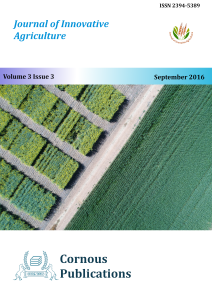Experiment was conducted to study the effect of different moisture conservation practices on soil moisture, growth and yield of foxtail millet under rainfed alfisol during 2014-15. The experiment consisted of seven treatments viz., T1 Broad Bed and Furrow, T2 Compartmental Bunding, T3 Ridges and Furrows, T4 Tied Ridges, T5 Basin Listing, T6 Vertical Mulching and T7 Flat Bed. The soil moisture content ranges from 0.4 per cent to 17.2 per cent and the highest soil moisture of 17.2 per cent was recorded during the flowering stage of the crop growth under tied ridges followed by ridges and furrows (15.5 per cent). The results on yield attributing characters and yield revealed that crop grown under tied ridges followed by ridges and furrows attained fifty per cent flowering stage at 45 DAS and physiologically matured 10 days earlier as compared to other moisture conservation practices. Significantly higher productive tillers plant-1 (16.4), ear head length (22.2 cm) and test weight (3.06 g) were registered with tied ridges treatment and the next best treatment was ridges and furrows. Similarly, grain was significantly higher in tied ridges though it was at par with ridges and furrows and compartmental bunding. Whereas, green fodder yield was significantly higher in tied ridges (6654 kg ha-1) and the next best treatments were ridges and furrows and compartmental bunding. Higher gross returns (Rs 84465 ha-1), returns above variable cost (Rs. 60965 ha-1) with a benefit-cost ratio of 3.6 were recorded with tied ridges.
One of the grand tasks of current taxonomy is to prepare a checklist of plants of the globe. This paper is based on the collection of angiosperm flora in family Convolvulaceae in particular between 2014 and 2015. The present paper reports 35 species under 9 genera of Convolvulaceae from Tripura district. Ipomoea is the largest genus with 18 species followed by Merremia with 4 species, Convolvulus and Argyreia with 3 species of the family Convolvulaceae. The family comprises annual and perennial, prostrate, twinning and trailing herbs. Moreover, 6 taxa were found to be shrubs.
On Farm Experiment was conducted at Ammayenthal village of Thirupathur block of Sivagangai District, Tamil Nadu during Kharif 2010 season to study the effect of mechanization in rainfed groundnut (decorticator, seed drill sowing) for drudgery reduction against conventional method, foliar nutrition with groundnut consortia and split application of N and K fertilizers on yield and yield attributing characters of rainfed groundnut. The On Farm Experiment was laid out in Factorial Randomized block Design with three replications. The soil of the experimental filed was sandy loam in nature. The treatments consisted of two shelling practices viz., farmers practice (manual hand shelling) and shelling through manual decorticator, two crop establishment methods such as manual sowing with country plough and seed drill sowing, two split application of N and K fertilizer viz., farmers practice (full basal) and three splits at basal, flowerings and pegging stage and two foliar nutrition viz., farmers practice (foliar spraying of 2.0 per cent DAP at fifty per cent flowering) and foliar nutrition with groundnut consortia at fifty per cent flowering and pegging stage. The results of the on farm experiment revealed that plant density load per unit area, leaf area index, fertility co-efficient, number of pods per plant, pegging percentage, shelling percentage, pod yield and haulm yield was significantly influenced by seed drill sowing, foliar nutrition with nutrient consortia and split application of N and K fertilizers. Groundnut shelling through manual decorticator had registered the lowest kernel damage and highest plant density per unit area as compared to conventional method of sowing. Whereas, lower yield and yield attributing characters were noticed with farmers practice. Significant interaction between crop establishment methods and nutrient management practices was observed and crop established through seed drill sowing and foliar nutrition with nutrient consortia and split application of N and K fertilizers gave maximum Benefit Cost Ratio (BCR) and higher net return as compared to rest of the treatments.
